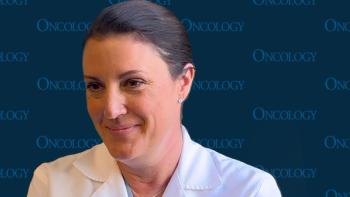
Estradiol benefits patients with resistance to aromatase inhibitors
Estrogen-receptor–positive advanced breast cancer patients who have become resistant to endocrine therapies can derive clinical benefit from 6-mg daily doses of estradiol, according to a phase II study conducted at Washington University in St. Louis.
SAN ANTONIO-Estrogen-receptor–positive advanced breast cancer patients who have become resistant to endocrine therapies can derive clinical benefit from 6-mg daily doses of estradiol, according to a phase II study conducted at Washington University in St. Louis.
While the exact mechanism of the treatment effect is unclear, "something profound is happening that allows these patients to become sensitive again to estrogen deprivation," said Matthew J. Ellis, MB, PhD, chief of medical oncology at the university's Siteman Cancer Center.
The study was a randomized trial of high-dose estradiol (10 mg t.i.d., 30 mg total) versus low-dose estradiol (2 mg t.i.d., 6 mg total) in 66 postmenopausal women with acquired resistance to aromatase inhibitors. Patients had to have evidence of a previous response (≥24 weeks) to an AI or a relapse occurring after two years or more of adjuvant AI treatment. If patients achieved a response or stable disease with estradiol therapy, they could be retreated with an AI (SABCS abstract 16).
In the intent-to-treat analysis, clinical benefit was achieved by 40.7% of patients receiving 30 mg estradiol and by 41.6% of those receiving 6 mg. This included response rates of 3% and 9%, and stable disease rates of 25% and 20%, respectively.
"A few patients got persistent disease control," Dr. Ellis said.
Time to treatment failure was shorter with the high-dose arm because more patients discontinued due to side effects, he added.
Tumor markers (CA27/29) also rose rapidly in response to estradiol, achieving pre-ovulatory levels of serum estradiol with the 6-mg dose and levels consistent with the first trimester of pregnancy with the 30-mg dose.
It was also possible to predict which patients would benefit from the therapy based on the occurrence of "PET flare," which was defined as a 12% or greater increase in FDG uptake 24 hours after estradiol challenge.
Among 46 patients who had FDG-PET scans, flare was seen in 100% of responders (three of three) and in 69% of patients with stable disease (nine of 13), but in only 10% of patients with progressive disease (three of 30).
"The positive predictive value for PET flare was 80%," Dr. Ellis said. "Without PET flare, the chance of responding was just 13%."
No difference between the doses in estradiol-induced FDG uptake was seen.
In a subset of patients who were retreated with an AI after responding to estradiol, some responded and stabilized for a year or so. This included one patient who responded to 6 mg estradiol for 48 weeks, then progressed and resumed exemestane, which resulted in disease control for another 36 weeks. She progressed again and was retreated with estradiol for 12 weeks. She is now being treated with fulvestrant, Dr. Ellis said, calling this component of the study "a work in progress."
Serious adverse events were significantly greater among patients receiving 30 mg/day, and this group also reported significant declines in quality of life (according to the FACT-B scale). Since the doses were equally effective, the 6-mg dose is recommended, he said.
"Estradiol 6 mg daily is a reasonable and cost-effective option for patients with ER-positive advanced breast cancer and acquired AI resistance in the absence of estradiol contraindications, though exactly how to use estradiol is something we need to study further," Dr. Ellis concluded.
Newsletter
Stay up to date on recent advances in the multidisciplinary approach to cancer.

















































































